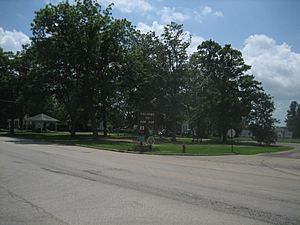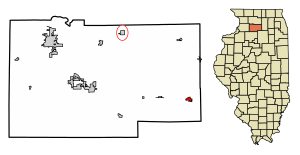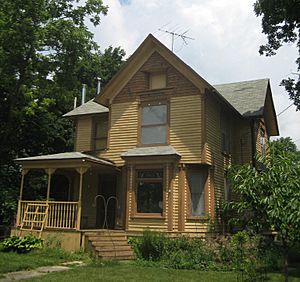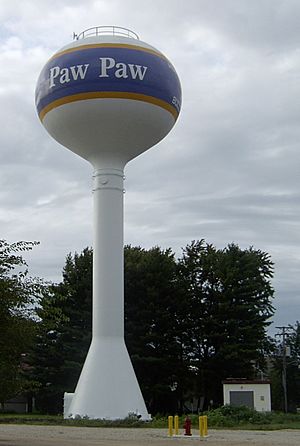Paw Paw, Illinois facts for kids
Quick facts for kids
Village of Paw Paw
|
|
|---|---|

Chicago Road as it enters the village of Paw Paw.
|
|

Location of Paw Paw in Lee County, Illinois.
|
|

Location of Illinois in the United States
|
|
| Country | United States |
| State | Illinois |
| County | Lee |
| Area | |
| • Total | 0.60 sq mi (1.55 km2) |
| • Land | 0.60 sq mi (1.55 km2) |
| • Water | 0.00 sq mi (0.00 km2) |
| Population
(2020)
|
|
| • Total | 830 |
| • Density | 1,385.64/sq mi (534.63/km2) |
| Time zone | UTC-6 (CST) |
| • Summer (DST) | UTC-5 (CDT) |
| FIPS code | 17-58226 |
| Website | http://pawpawil.org/ |
Paw Paw is a small village in Lee County, Illinois, in the United States. In 2020, about 830 people lived there. The village was first settled in the mid-1800s. By 1878, it had a train connection, which was a big deal back then! Paw Paw is also home to a special house. This house is so important that it's listed on the U.S. National Register of Historic Places. In 2005, the village received money from the government to build a new water tower.
Contents
History of Paw Paw Village
In 1829, a route called Chicago Road was part of a stagecoach line. Stagecoaches were like old-fashioned buses that carried people and mail. This road went from Galena, Illinois to Chicago. Before that, Potawatomi Indians used this trail. The tribe gave the land to the U.S. government in 1833.
The first person to live permanently in Paw Paw was David A. Town in 1834. He came from Vermont. The very first cabin was built the next spring by Edward Butterfield. This cabin was also the village's first store. Over time, different parts of the town, like East, West, and South Paw Paw, all became known simply as Paw Paw.
In 1837, William Rodgers became the first postmaster. Before him, the closest post office was 20 miles away! A new road was built in 1839. This road helped carry mail from Paw Paw to Princeton. The first stagecoach stop, called a "Tavern," was built by Isaac Balding. He ran it until the railroad came to town.
How Paw Paw Got Its Name
Even though people started settling here in the 1830s, by 1847, only about 50 people lived in the village. The name Paw Paw came from a nearby group of Pawpaw trees. These trees grew on the edge of a large forest.
An American general named Winfield Scott is thought to be the first European to find this area. Because there were many groups of Pawpaw trees, more than one settlement was called Paw Paw. To avoid confusion, the townspeople changed the village's name to Wyoming Township. This new name came from the Wyoming Valley in Pennsylvania. Many of Paw Paw's first settlers came from that valley.
Growth and Challenges
In 1850, Wyoming Township grew a lot. This happened even though it didn't get the important railroad link right away. By this time, the village had several businesses and a school. Finally, in 1878, the village got its train connection. It also had two newspapers and three churches. At this point, it was officially named Paw Paw again. The village was officially created in 1882.
In June 1890, a strong storm called a cyclone hit Paw Paw. It destroyed many buildings, including a schoolhouse. Sadly, 14 people died, and 7 of them were in the school.
In 2005, the Stephen Wright House in Paw Paw was added to the U.S. National Register of Historic Places. This is a special list for important historical places. It's the only property in Paw Paw with this honor. In the same year, the village received money to build a new, tall water tower.
Paw Paw's Population
| Historical population | |||
|---|---|---|---|
| Census | Pop. | %± | |
| 1880 | 476 | — | |
| 1900 | 765 | — | |
| 1910 | 709 | −7.3% | |
| 1920 | 665 | −6.2% | |
| 1930 | 559 | −15.9% | |
| 1940 | 523 | −6.4% | |
| 1950 | 594 | 13.6% | |
| 1960 | 725 | 22.1% | |
| 1970 | 846 | 16.7% | |
| 1980 | 839 | −0.8% | |
| 1990 | 791 | −5.7% | |
| 2000 | 852 | 7.7% | |
| 2010 | 870 | 2.1% | |
| 2020 | 830 | −4.6% | |
| U.S. Decennial Census | |||
In 2000, there were 852 people living in Paw Paw. There were 342 households, which are groups of people living together. About 228 of these were families. Most people in the village were White (98.71%). A small number were Native American or Asian. About 1.17% of the population was Hispanic or Latino.
About 31.3% of households had children under 18 living with them. Many households (54.1%) were married couples living together. The average household had about 2.49 people. The average family had about 3.09 people.
The population was spread out by age. About 27.7% were under 18 years old. About 15.1% were 65 years or older. The average age in the village was 38 years old.
Geography and Climate
Paw Paw is located at 41°41′16″N 88°58′57″W / 41.68778°N 88.98250°W. The village covers about 0.59 square miles (1.55 square kilometers) of land. It is close to Interstate 39, a major highway.
Paw Paw's Weather
Paw Paw has a humid continental climate. This means it has big differences in temperature between seasons. Summers are warm to hot and often humid. Winters are cold, and sometimes very cold. The climate type is known as "Dfa" (Hot Summer Continental Climate).
| Climate data for Paw Paw, Illinois (1991–2020 normals, extremes 1935–present) | |||||||||||||
|---|---|---|---|---|---|---|---|---|---|---|---|---|---|
| Month | Jan | Feb | Mar | Apr | May | Jun | Jul | Aug | Sep | Oct | Nov | Dec | Year |
| Record high °F (°C) | 64 (18) |
68 (20) |
83 (28) |
92 (33) |
95 (35) |
101 (38) |
101 (38) |
99 (37) |
93 (34) |
90 (32) |
76 (24) |
68 (20) |
101 (38) |
| Mean daily maximum °F (°C) | 27.9 (−2.3) |
32.2 (0.1) |
44.9 (7.2) |
59.0 (15.0) |
70.3 (21.3) |
79.6 (26.4) |
81.9 (27.7) |
80.3 (26.8) |
74.9 (23.8) |
62.5 (16.9) |
46.4 (8.0) |
33.3 (0.7) |
57.8 (14.3) |
| Daily mean °F (°C) | 19.9 (−6.7) |
23.9 (−4.5) |
35.4 (1.9) |
47.7 (8.7) |
59.3 (15.2) |
68.9 (20.5) |
71.8 (22.1) |
69.9 (21.1) |
63.2 (17.3) |
51.1 (10.6) |
37.2 (2.9) |
25.5 (−3.6) |
47.8 (8.8) |
| Mean daily minimum °F (°C) | 11.8 (−11.2) |
15.6 (−9.1) |
25.9 (−3.4) |
36.4 (2.4) |
48.2 (9.0) |
58.3 (14.6) |
61.7 (16.5) |
59.5 (15.3) |
51.5 (10.8) |
39.7 (4.3) |
28.1 (−2.2) |
17.7 (−7.9) |
37.9 (3.3) |
| Record low °F (°C) | −28 (−33) |
−33 (−36) |
−16 (−27) |
9 (−13) |
24 (−4) |
36 (2) |
41 (5) |
37 (3) |
29 (−2) |
16 (−9) |
−7 (−22) |
−20 (−29) |
−33 (−36) |
| Average precipitation inches (mm) | 1.60 (41) |
1.73 (44) |
2.19 (56) |
3.20 (81) |
4.83 (123) |
4.62 (117) |
3.90 (99) |
3.74 (95) |
3.58 (91) |
2.99 (76) |
2.44 (62) |
1.93 (49) |
36.75 (933) |
| Average snowfall inches (cm) | 9.6 (24) |
6.7 (17) |
3.6 (9.1) |
0.9 (2.3) |
0.0 (0.0) |
0.0 (0.0) |
0.0 (0.0) |
0.0 (0.0) |
0.0 (0.0) |
0.1 (0.25) |
1.7 (4.3) |
7.5 (19) |
30.1 (76) |
| Average precipitation days (≥ 0.01 in) | 8.3 | 7.0 | 8.9 | 11.2 | 12.0 | 10.7 | 9.2 | 8.7 | 8.1 | 9.0 | 8.3 | 8.7 | 110.1 |
| Average snowy days (≥ 0.1 in) | 5.3 | 3.9 | 2.1 | 0.6 | 0.0 | 0.0 | 0.0 | 0.0 | 0.0 | 0.1 | 1.1 | 4.1 | 17.2 |
| Source: NOAA | |||||||||||||
Education in Paw Paw
Public schools in Paw Paw are managed by the Unit 271 school district. This district runs Paw Paw Junior High School and Paw Paw Elementary School. Paw Paw Jr/Sr High School opened in 1841. However, it closed in 2019. Now, students from Paw Paw attend Indian Creek High School.
Notable People from Paw Paw
- George Bristow – An outfielder who played baseball for the Cleveland Spiders.
- Ulysses S. Guyer – A U.S. Representative (a type of politician) from Kansas.
- Jesse Harper – A well-known football coach.
- Robben Wright Fleming – An important educator.
See also
 In Spanish: Paw Paw (Illinois) para niños
In Spanish: Paw Paw (Illinois) para niños



